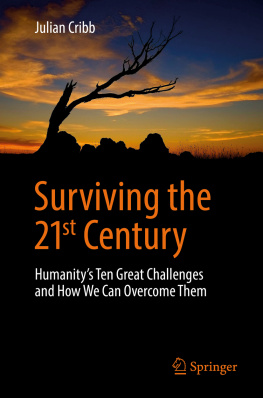1. The Self-Worshipper ( Homo suilaudans )
Velvet night enfolds the African savannah. The last light of day vanished half an hour ago; beneath a panoply of starlight filtered by scudding cloud a boy picks his way home across the veldt, following a familiar track. As he approaches Black Hill, the place where his family takes shelter at dusk each day, the ground becomes rough and uneven, limestone boulders litter the grassy slopes leading up to a rocky outcrop, groined by eons of rain and wind into a natural fortress of low cliffs, meandering crevices, shallow caves and sheltersa place even ferocious predators avoid once darkness has fallen.
His attention focused on the uneven footing, the youngster fails to detect the deeper shadow in the tree that overhangs this narrow part of the track, beaten by many feet over long ages. Indeed, the tree itself is hardly to be seena black silhouette against the fitful starshine. In daylight the tree appears old, rotten, stripped of foliage, devoid of any place to hide, a gaunt object not to be feared. Only on a moonless night like this is it a menace, as the old woman has often warned. But the youth is daring, lithe and strong. Home is close. The path underfoot skirts the boulders, weaving among the rising outcropsall other ways are far more difficult, treacherous, and just as risky. He should not have stayed out so long, hunting, to prove his prowess and pride. As he passes beneath the outstretched arm of the tree, a shadow blacker than the blackness overhead launches itself silently, blotting out the dim vault of the sky. The youth knows a moments panic, total terror and excruciating agony before his neck is expertly snapped. Teeth like daggers sink into his face and skull and, in a series of brutal tugs, the limp body is withdrawn silently into the dry grasses, heaved down the hillside to a lair where a hungry brood awaits.
Huddled safe in their rocky hilltop haven the family wait in vain, wait for the return of day, mourning yet another member of their clan to fall to the ruthless serial killer who stalks them in dreams as well as in reality. Not the first, by any means. One of a long, long line of child victims stretching back tens of thousands of years, hundreds of thousands, millions even.
The killing is real.
It took place sometime between 1.8 and 1.5 million years ago. The victim was a child, probably a young male from a small family group of Paranthropus robustus , a ruggedly-built extinct relative of modern humans, who regularly made use of the rocky shelters around Swartkrans, in the bushveld not far from Johannesburg in South Africa. We know how it happened because archaeologist Robert Brain, whose team unearthed the grisly forensic evidence, says
Another insight into this came to light at Swartkrans when we found that the back of the skull of a child had two small round holes in its parietal bones. I noticed that the distance between these holes was matched very closely by that of the lower canines of a fossil leopard from the same part of the cave. My interpretation was that the child had been killed by a leopard, probably by the usual neck-bite, and then picked up with the lower canines in the back of the head and the upper ones in the childs face. It was then carried into the lower parts of the cave, and consumed there (Brain ).
Brains analysis of the remains of other prey animals, especially baboons, revealed that leopards had a habit of chewing the bones but leaving the hard dome of the skull untouched, a grim testimony of ancient slaughter to a modern humanity which has mostly long since forgotten what it is to be the hunted, rather than the hunter.
Yet, around the same time, and in exactly the same place, another equally remarkable event is taking place: people are discovering the use of fire. And of something far, far more important.
The site of Swartkrans, not far from Pretoria and Johannesburg in South Africa, offers the first definitive evidence for the control of fire by pre-humans . In a memorable letter to Nature in December 1988, Brain and colleagues reported During recent excavations of hominid-bearing breccias in the Swartkrans cave altered bones were recovered from Member 3 (about 1.01.5 Myr BP) which seemed to have been burnt. We examined the histology and chemistry of these specimens and found that they had been heated to a range of temperatures consistent with that occurring in campfires. The presence of these burnt bones, together with their distribution in the cave, is the earliest direct evidence for use of fire by hominids in the fossil record (Brain and Sillent ).
The dating is imprecise, but the rock stratum containing burnt bones and other traces of fire is between a million and a million-and-a-half years old. The childs punctured skull was found in a layer at the same site dated at one and a half million years, or a bit older.
Although there is no direct link between the actual killing and the use of fire, other than the shared location, the inference that fire was first adopted by humans as a defence against predators such as leopards is reasonable and has been widely accepted by archaeologists. It is probable that cooking followed soon after, bringing many health and dietary benefits. All animals are afraid of fire, especially of the vast wildfires that rage across the worlds savannahs, fuelled by grasses cured to tinder in summer heat, ignited by lightning strikes, and fanned by hot, fierce winds. Even when these fires die down, animals avoid the smouldering areas. There must have been a special threat, and a special fear, that drove these prehuman creaturesanimals with brains not a great deal larger than a modern chimpanzeesto beat down their natural instinct to avoid fire at all costs, to gather up the embers, to carry them carefully back to the home site and there conjure the flames forth again.
Pre-humans had been walking the grasslands of Africa for at least six million years before fire came to Swartkrans. They had no doubt fled wildfires many times and seen other animals, leopards included, do the same. To conquer their own fear of fire, and to exploit the leopards, was a spectacular leap forward into the age of humanity. To do such a thing requires a very special skill: the ability to look into the future, to imagine a possible threatand to conceive, in the abstract, a way of meeting it. The site of Swartkrans captures both moments in the phenomenal ascendancy of humans. This unexceptional, low, grassy African hill with its rocky crown marks the birthplace of wisdom.
To use fire as a defence against leopards requires the user first of all to imagine the family being attacked by leopards in the futurenot hard to do in view of the chewed bones found in the leopards lair, suggesting this was a not-infrequent event. Most animals can imagine a threat from their predatorsand the necessity for avoiding it. But then it requires the ability to envisage something the leopard itself fears more than hunger; to step outside oneself and enter the mind of a leopard. Next it demands the ability to see that if one can vanquish ones own instinctive fear of fire, it may confer a decisive advantage in the unequal contest between carnivore and child. And then the ability to see that fire can be carried, nurtured, built up, sustained, both day and night, in an age when matchsticks lay more than million years into the future. Fire itself demands foresight. It must be fed with dry grass, leaves, twigs, logs, tended incessantly for days, weeks, months maybethrough rain, wind and cold. This is not a task for an individual; it requires an act of mutual understanding and co-operation by the whole family group. It probably entails the organised collection and storage of a stock of dry fuel for the hours of dark and days of rain, when no-one dares to venture beyond the cave. If the fire goes out, as the classic 1911 Belgian novel Quest for Fire so lyrically recounts, the fate of the entire family hangs in the balance (Rosny ).











